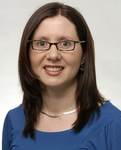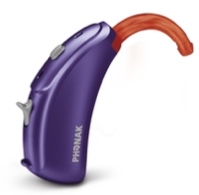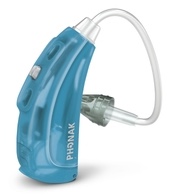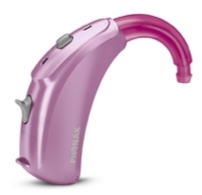Ready for Success - Phonak Solutions to Support Children with Unilateral Hearing Loss
AudiologyOnline: Why have you decided to do a campaign specifically geared toward children with unilateral hearing loss?

Angela Pelosi: At Phonak, we want to give every child, no matter what degree or type of hearing loss, the opportunity to hear and understand well in every situation so they can develop speech, communicate effectively, play, laugh and be confident in everything that they aspire to be or do. And that also means the 3 out of 100 school aged kids that may have some degree of unilateral hearing loss (UHL). Untreated UHL may result in language delays, but may also cause a child to suffer from fatigue, feel withdrawn or leave them susceptible to a greater risk of social and emotional difficulties.
AudiologyOnline: Your campaign is called “Ready for success” - what does that refer to?
Angela: Historically, children with UHL were often not diagnosed until school age, when listening became more challenging and they started to struggle. More recently, with newborn hearing screening available, these children have been identified much earlier. However, they have often been managed under the ‘watch and wait’ philosophy. Studies have found that children with UHL are five times more likely to need extra academic resources and are up to ten times more likely to need to repeat a grade. Although hearing technology may not be the answer for every child with UHL, it is certainly recommended to try, in order to give children a better chance at hearing as much as they can. This is especially true for complex listening environments, where missing information from one side results in more difficulty. So, we offer solutions that perform well, are easy to use, and fun for children to wear. It’s not about waiting for these children to fail or waiting for them to need additional support; instead, it is about giving them tools so that they are ready for success from the beginning.

AudiologyOnline: Since UHL can encompass a wide range of hearing losses and challenges, do Phonak’s solutions work for them all?
Angela: You are right; children with UHL may have a mild hearing loss in the impaired ear, unusable hearing in that ear, or something in between. It is important to evaluate each child, and consider their age and situation. The American Academy of Audiology (AAA) addresses the diverse needs of children with UHL in their 2013 Clinical Practice Guidelines for Pediatric Amplification. They recommend a trial of amplification for a child with aidable hearing. For that, Phonak offers the Sky V family of hearing aids, with the unique automatic system, AutoSense Sky OS, designed specifically for children's ever-changing listening situations.
For children with severe to profound UHL or extremely poor speech understanding, then Phonak offers 2 solutions that are also mentioned in the guidelines. CROS systems have evolved over time and with the Phonak CROS II, children can now have the benefit of directional microphones to stream less noise to the normal hearing ear. AAA notes that some children may prefer the benefits of a remote microphone system, like the Roger Focus. Improving the signal-to-noise ratio directly at their normal ear, can mean improved speech understanding in noisy situations. In fact, Roger Focus has shown an average improvement of 53% for speech understanding in noise, for children as compared with not wearing anything. Some children in the study, even went from hearing nothing without technology in noise, to almost 100% with the Roger Focus.



AudiologyOnline: You mentioned the directionality in the CROS II transmitter, but are there other features in the solutions that might be uniquely beneficial to children?
Angela: At Phonak, we understand that a child is not just a small adult. So as mentioned before, the Sky V hearing aid has an operating system developed just for kids, but there are also features that make it easier to use than ever especially when used with the CROS II or with Roger. The goal of fitting a CROS is to bring conversation from the impaired side to the normal ear. For children especially, in a setting like the classroom where hearing and understanding peers and teachers in noise or from a distance is crucial to learning; they will need to also use a Roger system to get the most out of their educational day. But this set up of equipment presented challenges of the child having to select programs and know when to turn them on and off. With the RogerReady feature of the Sky V family, this barrier has been taken down. The child wears a Roger receiver on the Sky V on their normal ear, and a CROS II on the impaired ear, and lets the system do the work. The child can listen to the CROS signal as needed and then when the Roger microphone of the teacher, coach or scout leader is turned on, the Sky V automatically switches to the Roger + Mic program and the child can hear the signal from the microphone. When the Roger microphone is turned off, then the Sky V automatically goes back to the CROS program.
AudiologyOnline: Since Sky V, CROS II and Roger Focus have been available in the market for a while, are there any new changes you have made to them?
Angela: In fact, there are a few additional options now provided to make the CROS II more child-friendly. With the launch of our first Sky family, it was obvious that the pediatric color portfolio was a hit with children and their parents. And so we wanted to be able to extend the same options to those children wearing CROS II with Sky V. So as of this month, the CROS II-13 model will also come in the fun Mix & Match color combinations of the Sky V.
The CROS II-13 BTE has an optional earhook, which now comes in the 7 Sky V colors and is great for added retention with a well fitted earmold. We understand most pediatric professionals recommend CROS for children old enough to understand where sound is coming from, but also know they are faced with many families who are keen to try this solution as early as possible. So as an added measure, the CROS earhook was tested to meet the IEC standards for mechanical strength and security, and a tamperproof battery door is available if required.
AudiologyOnline: Thank you Angela. It seems you are being proactive with this topic now, but will there be any other initiatives Phonak will have for children with UHL?
Angela: With all of our pediatric developments we will continue to provide the best possible non-surgical options for unilateral hearing loss in both quiet and noise. Phonak will also be hosting a 2-day conference in Philadelphia in 2017 dedicated to the latest research and happenings in the field of pediatric unilateral hearing loss. We look forward to your readers joining us for this unique pediatric conference October 22-24, 2017. Watch the Trainings & Events page on www.Phonak.com for the latest information regarding registrations.
For more information on Phonak solutions for children with UHL, please visit www.phonakpro.com/uhl


